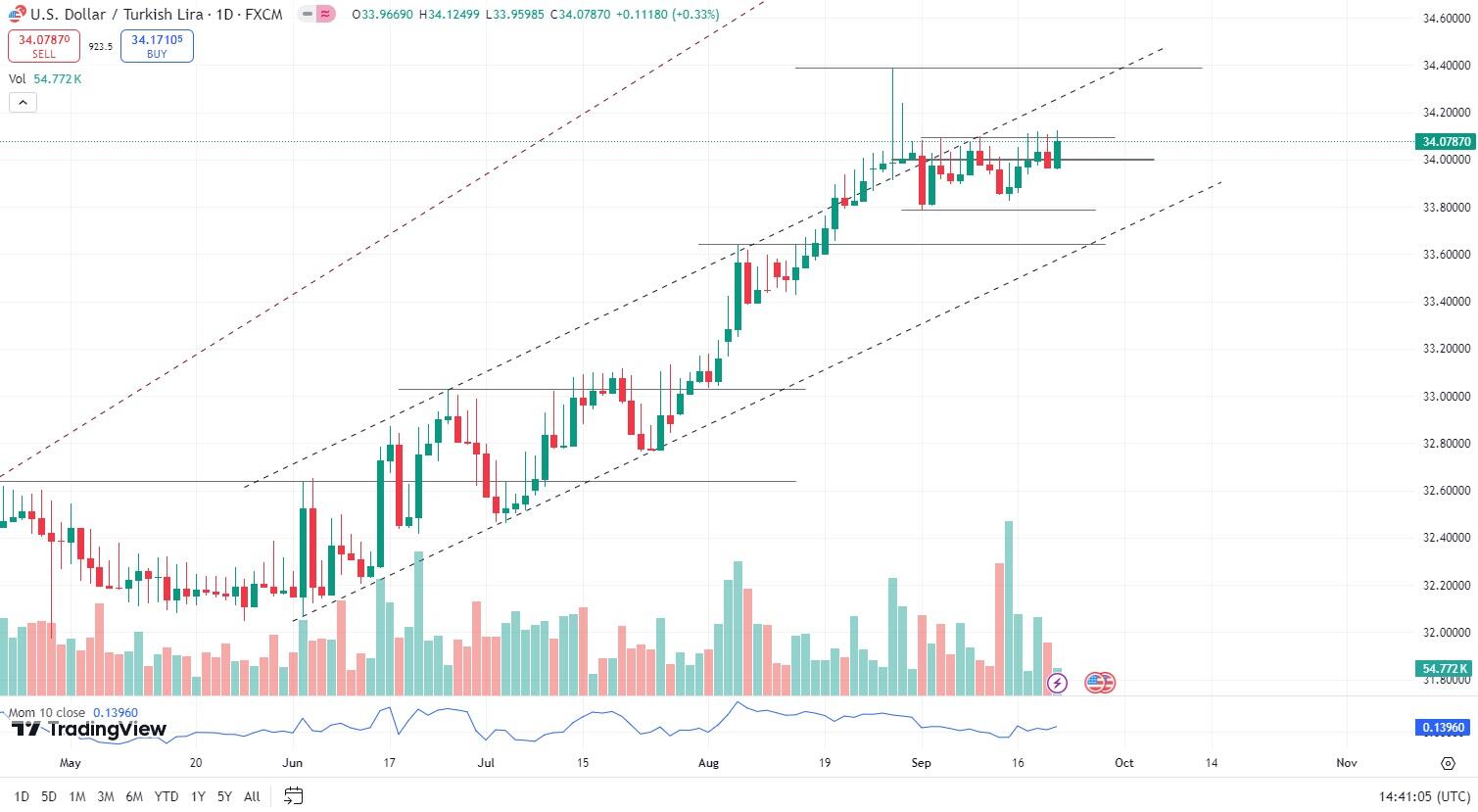Technical analysis
The USD/TRY pair closed at 34.078 on the FXCM platform last Friday (CBRT reference rate: 33.9531 - 34.0142). After breaking the resistance level around 33 in early August, the pair surged to a new all-time high of 34.388 on August 28. The exchange rate briefly retraced to 33.78 at the beginning of September and has been trading sideways since then, hovering near the psychological resistance of 34.
The pair has been in a strong, long-term upward trend that can be traced back to late 2021, showing no signs of exhaustion and without any significant retracement since August 2023 despite periods of deceleration. This trend is clearly visible in the weekly chart (Image 1). Since july 2023 the pair remains near the upper boundary of the ascending channel. Between March and June 2024 the pair entered a short term trading range, before regaining momentum over the summer, with alternating periods of rallies and consolidation. Notably, the last five candlesticks on the chart resemble the continuation pattern known as "Matt Hold," which often signals a pause before continuing the uptrend. As the same pattern showed up during last june, this string is consistent with a mild short term uptrend made of alternating hikes and consolidation periods (Image 2).
On the daily chart, while the overall long-term picture remains intact, a short-term uptrend began in June. Signs of fatigue became evident after the August peak, as the pair faces resistance in breaking decisively through the 34 level. Given the current trading range, key levels to monitor include support around 33.79 and resistance in the 34–34.10 area, with the August 28 peak at 34.39 as the next critical level (Image 3).
If the uptrend continues, Fibonacci extensions provide potential target areas at 35.29, 35.56 (50% extension), and 36.73 (double the extension). Additionally, the psychological level of 35 could serve as resistance as well.
Economic overview
Turkey’s economic landscape
Turkey is facing a challenging and complex economic environment, where predicting the Lira’s future is made difficult by multiple and conflicting forces. Hyperinflation has been a longstanding problem, peaking at 85.52% in late 2022. Since June 2023, the Central Bank of the Republic of Turkey (CBRT) has implemented a tight monetary policy to curb inflation, raising key interest rates to as high as 50%. At the same time, Turkish authorities have tightened credit regulations and adopted fiscal measures aimed at reducing the current account deficit and rebuilding foreign reserves.
Turkey grapple with other significant economic challenges, such as its current account deficit and its foreign currency-denominated debt, which make the country vulnerable to Lira volatility. The Lira’s depreciation has made servicing this debt more expensive, while the CBRT’s interventions to stabilize the currency have drawn down reserves in the recent past. Furthermore, while the Lira has weakened nominally, it is appreciating in real terms due to Turkey's high inflation, which has hurt the competitiveness of exports and dampened tourism.
The most recent CBRT survey, conducted in September, revised economic growth forecasts downward. Growth slowed to 2.5% in Q2 2024 from 5.3% in Q1, and the year-end growth estimate has been reduced from 3.4% to 3.2%. Despite some signs of stabilization, Turkey's economic outlook remains uncertain.
Monetary policy and investor sentiment
On the other hand, Turkey’s high interest rates and relatively stable currency have attracted foreign investors seeking higher returns. According to Bank of America, foreign investors have poured billions into Turkish assets, taking advantage of the Lira’s real appreciation and the attractive yields on bonds, such as the TLREF, which is indexed to the overnight reference rate set by the CBRT and offers returns of around 50%. This has bolstered carry trade strategies, where investors borrow at low-interest rates and invest in higher-yielding assets.
The CBRT has capitalized on this monetary inflows by rebuilding its foreign currency reserves. As of September, foreign exchange reserves increased to $92.16 billion, up from $86.57 billion in August, while official reserve assets rose to $149.4 billion. Additionally, the projected current account deficit for 2023 improved, decreasing from $25.5 billion to $22.2 billion.
Inflation, market sentiment and policy outlook
In its September meeting, the CBRT held its main policy rate at 50%, following data that showed a decline in annual inflation to 51.97% in August. Inflation is still at high levels and Households’ 12-month inflation expectations (a key indicator closely monitored by CBRT in its policy making) rose to 73.14% in August, up from 71.98% in July, indicating a gap between public expectations and the CBRT's disinflation goals.
This persistent inflationary pressure suggests that Turkey’s monetary policy will remain tight in the foreseeable future. Economists, including Morgan Stanley’s Hande Kucuk, predict that rate cuts will not begin until 2025, as the CBRT needs to see more progress in aligning inflation expectations with its targeted disinflation path.
USD/TRY outlook and geopolitical risks
According to the CBRT’s September market participants survey, the year-end exchange rate forecast for USD/TRY is 37.16 (slightly down from 37.27 in the previous month). Last week decision by the Federal Reserve to lower its policy rate by 50 basis points sparked only a mild reaction in the currency pair, suggesting that much of the cut had already been priced in.
While the CBRT remains committed to managing inflation and stabilizing the Lira, USD/TRY pair will likely maintain its recent mild uptrend, without any sharp movements in the near future, provided that the disinflation process continues and rates remain steady. However, geopolitical risks, such as the ongoing conflict in Ukraine and instability in the Middle East, or any domestic political issue could influence the pair, as the U.S. Dollar typically serves as a safe-haven asset in times of global uncertainty.
Note: All information on this page is subject to change. The use of this website constitutes acceptance of our user agreement. Please read our privacy policy and legal disclaimer. Opinions expressed at FXstreet.com are those of the individual authors and do not necessarily represent the opinion of FXstreet.com or its management. Risk Disclosure: Trading foreign exchange on margin carries a high level of risk, and may not be suitable for all investors. The high degree of leverage can work against you as well as for you. Before deciding to invest in foreign exchange you should carefully consider your investment objectives, level of experience, and risk appetite. The possibility exists that you could sustain a loss of some or all of your initial investment and therefore you should not invest money that you cannot afford to lose. You should be aware of all the risks associated with foreign exchange trading, and seek advice from an independent financial advisor if you have any doubts.
Recommended Content
Editors’ Picks

AUD/USD consolidates near 19-month peak as traders await US PCE Price Index
AUD/USD oscillates in a range below the 0.6900 mark, as traders opt to move to the sidelines ahead of the US PCE Price Index. In the meantime, the RBA's hawkish stance, the optimism led by additional monetary stimulus from China, the prevalent risk-on mood, and a bearish USD continue to act as a tailwind for the pair.

USD/JPY holds above 145.00 after the Tokyo CPI inflation data
The USD/JPY pair attracts some buyers to near 145.20 on Friday during the early Asian session. The pair gains ground near three-week highs after the Tokyo Consumer Price Index. The attention will shift to the US Personal Consumption Expenditures Price Index for August, which is due later on Friday.

Gold price holds steady near record peak; looks to US PCE data from fresh impetus
Gold price consolidates below the all-time high set on Thursday amid overbought conditions on the daily chart and the risk-on mood, though dovish Fed expectations continue to act as a tailwind. Bulls, meanwhile, prefer to wait for the release of the US PCE Price Index before placing fresh bets.

Ethereum investors show bullish bias amid ETF inflows and positive funding rates, exchange reserves pose risk
Ethereum traded around $2,640 on Thursday, up more than 2% following increased bullish bias among investors, as evidenced by ETH ETF net inflows and an uptrend in funding rates. However, investors may be wary of a potential correction from ETH's rising exchange reserve.

RBA widely expected to keep key interest rate unchanged amid persisting price pressures
The Reserve Bank of Australia is likely to continue bucking the trend adopted by major central banks of the dovish policy pivot, opting to maintain the policy for the seventh consecutive meeting on Tuesday.

Five best Forex brokers in 2024
VERIFIED Choosing the best Forex broker in 2024 requires careful consideration of certain essential factors. With the wide array of options available, it is crucial to find a broker that aligns with your trading style, experience level, and financial goals.

-638626422165989756.jpg)

